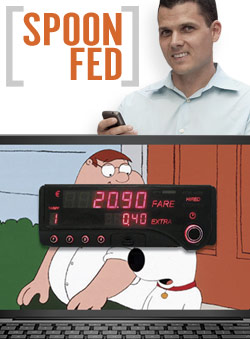The Mobile Broadband Speed Tax: Got $23 for a Hulu Episode?
The next generation of mobile broadband is upon us. And it’s fast. So fast, in some cases, that many consumers will consider ditching their home cable or DSL connection. Why not just pay a single bill for surfing the web on your sofa and on the go? Because you might not be able to afford it.
Today T-Mobile announced that it will charge 20 cents per megabyte for those who go over the 5GB cap for its new high-speed HSPA+ service. While the amount of this penalty isn't new, its four times what other carriers charge, and you’re more likely to blow past 5GB when you have more speed. Meanwhile, Verizon Wireless says it will likely put an end to its unlimited plans for its upcoming 4G LTE network. Think of it as a mobile broadband speed tax.
With T-Mobile’s new webConnect Rocket USB laptop stick ($99 with contract, $199 if you decide to go from month to month), the carrier promises blazing theoretical peak speeds of 21 Mbps on its new HSPA+ network. The first market is Philadelphia, but the footprint should be national by the end of the year. Of course, real-world speeds will be lower. But make sure you watch that data meter.
According to some early tests conducted by Mobile Burn, downloads averaged 5.6 Mbps, and uploads averaged 1 Mbps. Still, that’s more than triple the throughput offered by traditional 3G services. You should be able to stream an episode of Family Guy or Lost on Hulu at full screen without any stuttering or buffering delays.
The good news is that T-Mobile will charge you $50 instead of $60 per month for 5GB of data if you decide to pay more for the modem up front and skip the contract. That’s a savings of $140 over 2 years, including the cost of the device. The bad news is that you’ll likely reach that 5GB cap faster than you would with a slower 3G connection card because you’ll want to do more with it. And that whopping 20 cents per MB surcharge works out to $23.40 for a half-hour Family Guy episode (at full screen). You could watch 42 episodes before you reached that cap, but that wouldn’t include any other online activity.
T-Mobile told us that it isn’t positioning webConnect as a home broadband replacement, and its pricing ensures that won’t happen. Still, I think potential buyers would much rather see a separate tier (say, $80 for 10GB) then have to worry about getting zapped. How much less channel surfing would you do at home if your cable company charged you by the minute?
Verizon Wireless is also gearing up to offer faster mobile broadband using a different technology called LTE, promising 5 to 12 Mbps downloads and impressive 2 to 5 Mbps uploads in 25 to 30 markets this year. Just don’t expect the same $60 per month flat rate for data as the carrier charges for 3G. Verizon Wireless CTO Anthony Melone told The Wall Street Journal yesterday that offering “as much data as you can consume is the big issue that has to change.” Melone stressed that he doesn’t want his customers to worry about how much they can stream, but hearing him say “all you can eat is gone” makes me wonder what the speed tax will be.
Sign up to receive The Snapshot, a free special dispatch from Laptop Mag, in your inbox.
To be fair, all of the carriers are spending billions to upgrade their networks, and they will need to find ways to recoup their massive investments. That’s why it’s so interesting that Sprint is charging the same amount for its 4G service as it is for 3G: $60 per month. Assuming you’re in a 4G coverage area (27 markets and counting), you can use as much data as you like on a device such as the Sprint Overdrive and not pay any overage fees. In other words, it’s truly unlimited. The catch is that Sprint’s 4G service isn’t as fast as T-Mobile’s HSPA+ or what Verizon promises with LTE. In Las Vegas, we saw a good average downlink speed of 4.5 Mbps on the Sprint Overdrive, but only 550 Kbps on the uplink (Don’t expect to enjoy smooth Skype video calls). Clearwire’s own plans are even more affordable than Sprint’s. A low $40 per month get you unlimited data using its USB modem. However, at that price you won’t have 3G to fall back on when you’re out of 4G range.
We’re just in the early days of next-gen mobile broadband, and it’s clear that carriers will be experimenting with different pricing plans that take into account both the money required to make those increased speeds a reality and the increased amount of data subscribers will likely consume. However, I’m pretty sure charging 20 cents a MB isn’t the way to go, even if you include a data usage meter. I’m okay with a speed tax, but only if it’s fair.
Editor-in-chief Mark Spoonauer directs LAPTOP's online and print editorial content and has been covering mobile and wireless technology for over a decade. Each week Mark's SpoonFed column provides his insights and analysis of the biggest mobile trends and news. You can also follow him on twitter.


